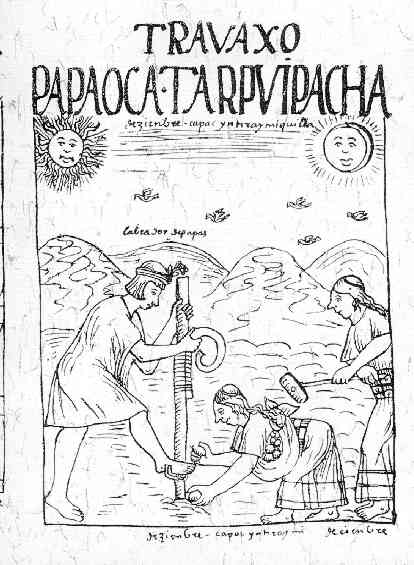A porridge made from the pseudo-grains of Chenopodium – quinoa and cañahua – was the Incas staple food. Maize and potatoes were also important food sources along with many other elevationally restricted tubers. The Incas were largely vegetarian but supplemented their diets with llama and alpaca meat and seafood when they could. Inca fishermen in small reed boats caught anchovies, sardines, tuna, salmon, sea bass, and shellfish. The Inca maintained herds of llama and alpaca, which were vital to Andean life. They provided wool, meat, leather, and transportation for the army, as well as being sacrificed in religious ceremonies. The larger state-owned herds were in the tens of thousands of animals and were meticulously counted in a state census each November.
Grains were prepared for cooking by pounding them between stone mortars or with a pestle. They were often flavored by adding herbs and spices, in particular chili peppers. Maize was cooked in small cakes or toasted and popped for a special treat. Potatoes were freeze-dried in the dry mountain air to produce chuño, which could be stored for long periods of time. Mildly alcoholic chicha was the most popular drink, a fermented beer-like drink that was prepared by chewing maize or other plants and allowing the pulp to ferment for several days. Wild fruits and nuts also provided valuable Inca food sources.
Culture and land use
The emperor, in addition to having personal and royal property, had dominion over newly conquered lands which he could distribute to the nobility, warriors and common folk, like the Aztecs. However, owners of conquered lands were not always displaced and were commonly allowed to continue working their lands. To do this, they were required to share the profits of the land with their new owners. The nobility and warriors given land were also required to pay part of the profit from those lands as a tribute.
Common people were not given land directly, but instead were allowed access to land through an ayllu, a collection of related households who worked an area of land together. Each ayllu commonly had some land in both the highlands and lowlands allowing them to produce a diversity of foodstuffs.
Agriculture was a community activity; farmers worked together in small teams of seven or eight, with the men hoeing and women following, breaking up clods and sowing seeds. Children and young adults were charged with taking care of the family’s herd of camelids. Newlyweds were given land to grow their own maize called a tupu (about 1.5 acres), and when their first child was born, they were given another half tupu. If the owner of the land died without an heir, the land was returned to the ayllu for redistribution.
Eco-geography and agricultural practices
The Inca Empire covered a huge expanse of territory encompassing the Andes and coastal regions. The Incas were ambitious farmers, and to maximise agricultural production, they dramatically transformed the landscape with terracing, canals, and irrigation networks, whilst wetlands were often drained to make them suitable for farming. In addition, the Incas were fully aware of the values of regular crop rotation, and they also fertilized the land with dried llama dung, guano, or fish heads if these materials were available.
Food stuffs were stored in storehouses (qollqa) which were built in the tens of thousands across the empire, typically arranged in neat rows and near population centres, large estates, and roadside stations. State officials kept careful accounts of their stocks using the quipu, a recording device of strings and knots. Qollqa were single-roomed stone buildings, either circular or rectangular, which were built in a remarkably uniform manner. Placed on hillsides to take advantage of cool breezes qollqa were designed to maximise the storage time of the perishable goods with which order to win favour from the gods and the elements. In addition, the harsh Andean environment meant that agriculture was viewed almost as a form of warfare. As the historian T. N. D’Altroy described it: “The Incas approached farming with weapons in their hands and prayers on their lips” (pg. 276).
There were also many sacred fields in the Inca capital Cuzco. The harvest from these was used as offerings in shrines, and one particular field was reserved for the ceremonial planting of the year’s first maize. It was here, in the month of August, that the Inca king ceremoniously tilled the first soil of the year with a golden plough. The sacred Coricancha, which had a temple to the Inca sun god Inti, even had a life-size field of corn made purely from gold and silver complete with precious metal animals and insects. When the Incas conquered a territory, they divided the land and livestock into three unequal parts – one for the state religion, one for the king, and one for the local inhabitants.
Agricultural tools and implements
Both copper and bronze were used to make basic tools and weapons. Among their tools were shovels, knives with curved leaves, axes, chisels and needles. Land was worked using simple tools such as a hoe (raucana), clod breaker (waqtana), and foot plough – the chakitaqlla, which consisted of a wooden or bronze pointed pole that was pushed into the ground by placing one’s foot on a horizontal bar. Hoe blades were typically made using sharpened cobble stones.
Illustration Inca farmers using a chakitaklla, by Felipe Guaman Poma de Ayala: El primer nueva corónica y buen gobierno (1615/1616). From Wikimedia Commons – File:Trabajo-inca8.jpg
Bibliography:
Cartwright, M. (2015a). Inca Food & Agriculture. World History Encyclopedia. Retrieved from https://www.worldhistory.org/article/792/inca-food–agriculture/
D’Altroy, T.N. (2014) The Incas. Wiley-Blackwell
Hancock, J. F. (2022) World Agriculture Before and After 1492: Legacy of the Columbian Exchange | SpringerLink
Whitmore, T. M., & Turner, B. L. (1992). Landscapes of cultivation in Mesoamerica on the eve of the conquest. Annals of the Association of American Geographers, 82(3), 402-425.
